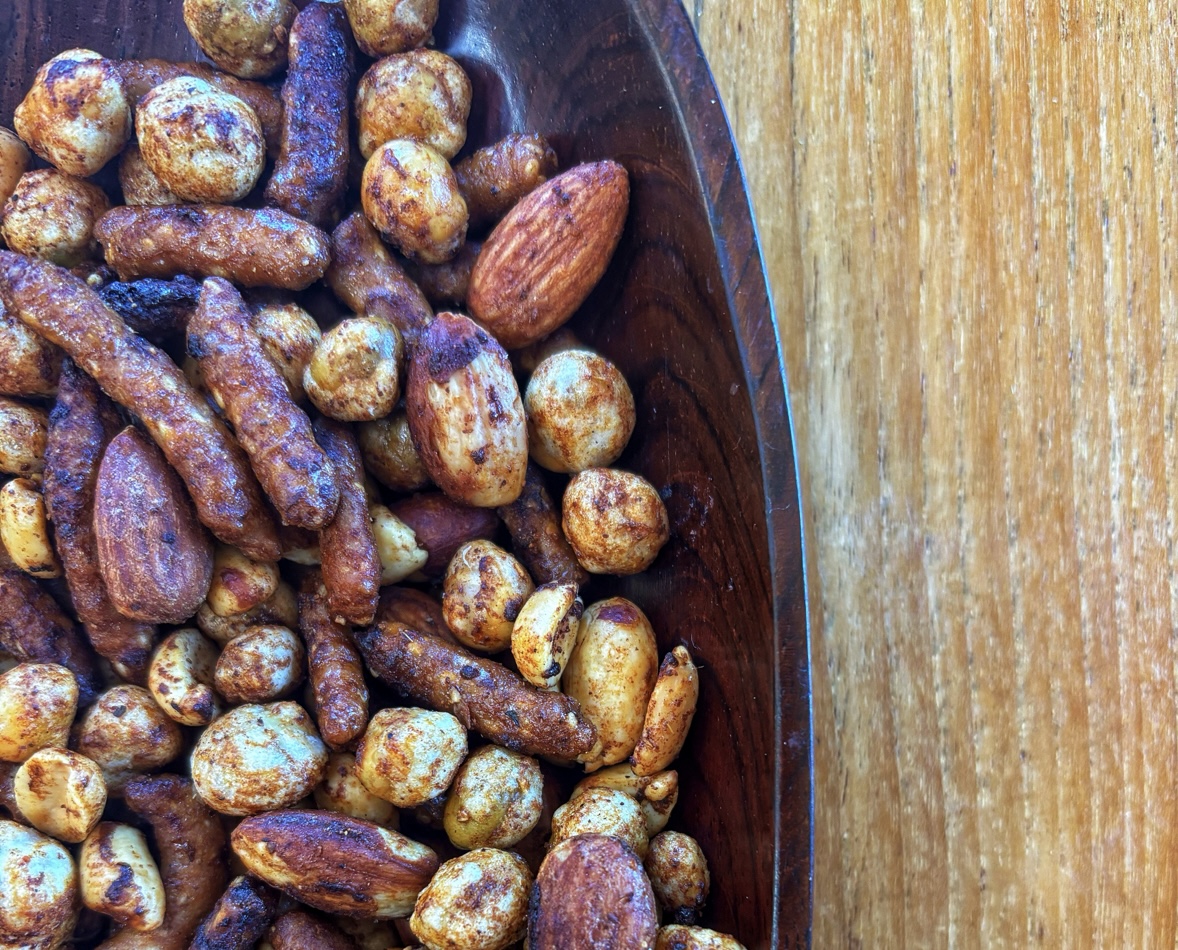Since our last update, Jim and Janet spent some time in New Orleans enjoying Mardi Gras. One of their favorite things to do while there was eat.
Among the new foods they tried was Gumbo along with one of their favorites, Fried Green Tomatoes. The Andouille sausage in the Gumbo was also new to them, so they asked the waitress to tell them a bit more about it, so that they could better understand the flavor. Thy also enjoyed a steak with wine reduction sauce at Brennan’s Restaurant, raw and boiled shrimp, red beans and rice – which they learned in New Orleans the beans and sausage are not cooked together as they are in other parts of the country. When served, the beans sit atop the rice.
As for this week’s challenge, Chef Miki is pleased with the progress, noting that Jim is getting used to trying most ingredients and seems to have conquered his aversion to trying new textures.
This week, she offered up suggestions for Pan Seared Pepper-Crusted Pork Tenderloin and Baby Dutch Yellow Potatoes.
RECIPE:
THE PORK – If you purchased the cut tenderloin, butterfly the slices by using a very sharp knife. Lay the slice on a clean, anchored, cutting board. You can place a damp towel or paper towels under your cutting board to prevent slippage if you don’t have a rubber mat. Place one hand on top of the slice of meat and cut the meat horizontally in equal halves without completely cutting through. Stop cutting at the same distance as the slice is thick. Open the butterfly and proceed with the recipe instructions. If you have a very thick piece of meat, 1 inch or greater, then follow the same process but slice completely through to make two, 1/2 inch slices. Do not butterfly if slices are less than 1/2 inch thick. Pork, nowadays, can be slightly pink in the center, but not raw. The juices still need to run clear. Be careful not to overcook pork-it can become newspaper or jerky quickly as it is so lean.
SEASONING THE PORK – This recipe is for four servings. If you are serving only two, then use only HALF of the olive oil, mustard, and thyme. SEARING:The method of searing meat is used to create a browned crust. Some people think that searing also seals in juices, but many chefs sear in hopes that there will be bits of meat stuck to the pan to create ‘fond’ which flavors pan sauces. For successful searing, the pan must be oiled and very hot before placing the prepared meat in the pan, or the meat will stick, similar to meat that sticks to a not-quite-ready barbecue grill. This is why a heavy pan or cast iron pan works well. It holds the heat throughout the searing process. In this recipe, and with recipes that stir fry meat, a tender cut is used since the only cooking the meat will have is usually the searing process. The pan is ready to sear when it is fully heated and a few drops of water carefully flicked into the oiled pan dance. If the oil is smoking, do not test with the water.
Just remove pan from heat to cool and begin again. The pan is way too hot and can burn, not brown your meat. To keep the high level of heat in the pan, sear meat in batches. Otherwise, you’ll need to wait for the pan to reheat. Feel free to add a small amount of additional oil to keep meat from sticking, allowing the pan to reach its searing temperature. Searing is also done to tougher cuts of meat to theoretically seal in juices while yielding a nice crust which adds flavor to the braising liquid. Some recipes call for dusting the meat with flour. This also aids in th ickening the braising liquid.
I LIKE SAUCE – so keep the sauce at the same amount . It’s REALLY yummy with a side of roasted fingerling or mashed potatoes, or polenta.
If you choose to reheat any leftover sauce, heat it slowly as the emulsion can break. If it does, then let it come to full temp without boiling, then add a chip of ice while swirling, continuing to add a chip at a time until it comes together. You need to heat the sauce, yet make it cool enough for the fat to redistribute. If you have a very high powered blender and at least one cup of left over sauce, you can cheat by running the sauce on high, but this will also add a lot of air to the sauce, making it frothy rather than silky.
VEGETABLE ACCOMPANIMENT- Currently, many Asians are celebrating Chinese New Year, so let’s be a little different and try some Chinese broccoli, better known as gai lan, with water chestnuts and pine nuts:
The gai lan may be blanched ahead of time and refrigerated. Just be certain to drain and blot dry any water. the jicama, water chestnuts, and pine nuts can all be prepared ahead of time and refrigerated until you are ready to sauté or stir fry.
Gai lan-When selecting gai lan, look for bunches with firm stalks, crisp leaves, and tightly closed yellow buds. Wash well with cold running water and pat dry. Trim off 1/4 inch of bottom, cut stalks into 2 inch pieces and trim off leaves to cook separately. No need to blanch the leaves; just add them to the stir fry toward the end just until they wilt.
Here is a tip on blanching vegetables:
Jicama-If you cannot locate fresh or water-packed water chestnuts in the produce section, then substitute with jicama. Select smaller jicama as they tend to be juicer and less woody. Avoid cracks, shriveling, or soft spots. Store in a cool spot until ready to use. Wash well and carefully remove thin skin with a peeler. Carefully cut jicama in half for ease of preparation; tightly wrap unused portion in plastic and refrigerate. For this recipe, cut the jicama into thin, 1/8 thick, 1 inch squares. Any unused jicama is great eaten raw with carrots or other veggies. The secret about jicama is that it doesn’t go limp when cooked!
Water chestnuts-If you are fortunate enough to locate fresh ones, select those that are firm with no dark spots or mold. The stem and base should be firm as well. Wash well and carefully peel outer brown skin. Cut white flesh into 1/8 inch rounds. If purchasing water packed, drain into a colander and rinse well. Blot dry.
Pine Nuts-These nuts are very high in fat content and become rancid quickly. Store leftover pine nuts in an airtight container and refrigerate or freeze. I prefer to freeze my nuts in a labeled container, remove as much as I need, and toast them before including in my recipes. They are terrific in salads, in baked goods, and, of course, for pesto! Use them within six months of freezing.
For toasting pine nuts, click here.
For more of Chef Miki’s tips on making this recipe, click here
STARCH – Serve with some ‘roasted until fork tender’ baby potatoes.
@@page
Here is what Janet and Jim had to say about Chef Miki’s suggestions:
Well, you were right, it is fun to slop up the sauce. This has been our favorite so far. The tenderloin with a little peppered crust, yum. Then, with the sauce, that made it perfect. I served it with mash potatoes. I am, however, having trouble it seems to prepare the third food item you suggest. It takes all I have when trying something new to coordinate more than two food items.
Jim likes the mustard flavor on the pork and pouring the sauce on his mash potatoes. He said, the flavors of the meat and the sauce were very strong and distinct and I think that’s why he liked it.
As for me, this was very easy and I think a working mom could prepare this meal in no time. This is the first time I have prepared a tenderloin on top of the stove. It was quick and so delicious. I feel that we have met another one of our challenges, which is taking a meal that we have eaten regularly and jazzed up the recipe to actually make it different. It was a pleasure.


